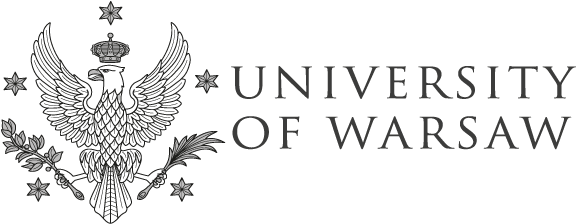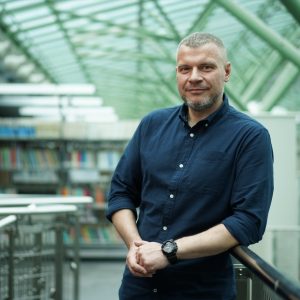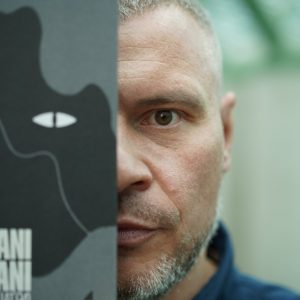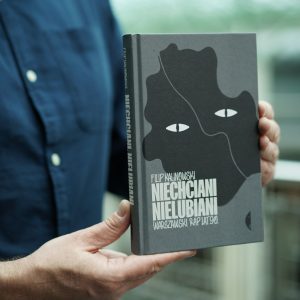How to teach Polish as a foreign language? Can rap be helpful with that? Is hip-hop culture just music, or is it something more? Dr Piotr Kajak, deputy director of the Centre of Polish Language and Culture for Foreigners “Polonicum” at the University of Warsaw, seeks answers to these questions in the “Read with the UW”series. In the new episode, the researcher presents a book by Filip Kalinowski – Niechciani, nielubiani. Warszawski rap lat 90.
Dr Piotr Kajak is a cultural studies scholar, Slavist and political scientist specialising in teaching Polish as a foreign language. He is an assistant professor and deputy director at the Centre of Polish Language and Culture for Foreigners “Polonicum” at the Faculty of Polish Studies at the University of Warsaw, where he heads the Pedagogy of Polish Language and Culture Laboratory and the Research Group on Polish Language and Culture in East and South Asia.
He is a member of the State Commission for the Certification of Proficiency in Polish as a Foreign Language and the Polish Language Outside the Borders Team (PL: Zespół Języka Polskiego poza Granicami Kraju) of the Council for the Polish Language at the Presidium of the Polish Academy of Sciences. From 2011 to 2014, he was a visiting professor at the Department of Slavic and East European Languages and Cultures at the University of Toronto. He has lectured at dozens of universities on three continents.
Dr. Piotr Kajak is the author and co-author of monographs, textbooks and many scientific articles. His research focuses on glottodidactic cultural studies, intercultural Polish studies, public diplomacy and the history of teaching Polish as a foreign language.
Rap a tool for education
The Centre of Polish Language and Culture for Foreigners “Polonicum” at the University of Warsaw is a unit that promotes Polish language and culture in the world. The pre-war initiative of teaching Polish language and culture to foreigners in the summer holidays was revived in 1956, which means that the “Polonicum” itself will soon celebrate its 70th anniversary. However, as Dr Piotr Kajak points out, the tradition of teaching Polish to foreigners at the reborn University of Warsaw – connected with Warsaw’s Polish studies – is almost 100 years old.
“In January 1926, Witold Doroszewski, a well-known linguist, conducted the first Polish language course for foreigners at the University of Warsaw between the wars,” explains the researcher.
Polish is not one of the most popular languages in the world, so elements of Polish culture – not only highly artistic, but also popular culture – are very important in its teaching.
“Learners of the Polish language often ask about everyday aspects of life in Poland, including subcultures and music. Popular culture, especially hip-hop, is an important point of reference,” says Dr Kajak, adding: “Rap is currently the most popular music genre in Poland, so it is worth reminding students of its roots, also during classes.”
Stories from backyards
In the book Niechciani, nielubiani. Warszawski rap lat 90. by Filip Kalinowski, we learn about the beginnings of Polish rap, which, before it hit the mainstream, was the voice of youth from Soviet-style apartment estates. The author – with strong ties to Warsaw’s Ochota district – goes back to the 1990s, showing what the birth of the genre looked like in Poland.
“It is the locality: backyards, blocks of flats, staircases, that constitute the strength of this narrative,” emphasises Dr Piotr Kajak.
The author sets his story in the context of transformations, violence, drug addiction and the emerging hip hop culture in Warsaw. It is a meticulously documented historical and social reportage.
“The book has a fan feel to it – it is the work of an enthusiast who is able to look critically, but also with a clear sympathy for the world he describes,” notes Dr Kajak.
The very title Niechciani, nielubiani is a direct reference to the legendary album Skandal by the group Molesta Ewenement – one of the pillars of Polish hip-hop. The book also contains threads about the band Trials X, Bogna Świątkowska’s cult radio programme Kolorszok, the influence of skateboarding on the development of rap in Poland, as well as formations such as ZIP Skład and Warszafski Deszcz.
“Thanks to this publication, we return to places that no longer exist or have changed irrevocably. We listen to the voices of the artists who laid the foundations of the rap scene, while learning about the process of transformation – cultural, social and urban. A transformation that is still going on today,” emphasises Dr Piotr Kajak.
Niechciani, nielubiani. Warszawski rap lat 90. by Filip Kalinowski is in free access at the University of Warsaw Library.







